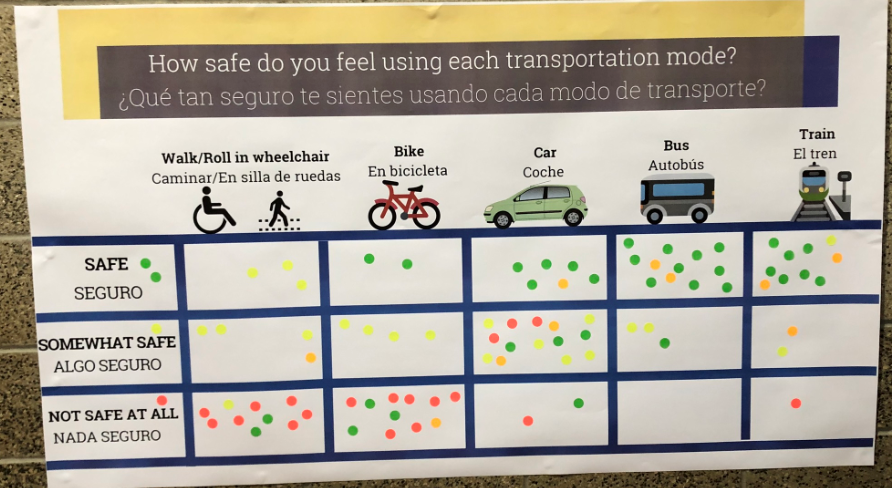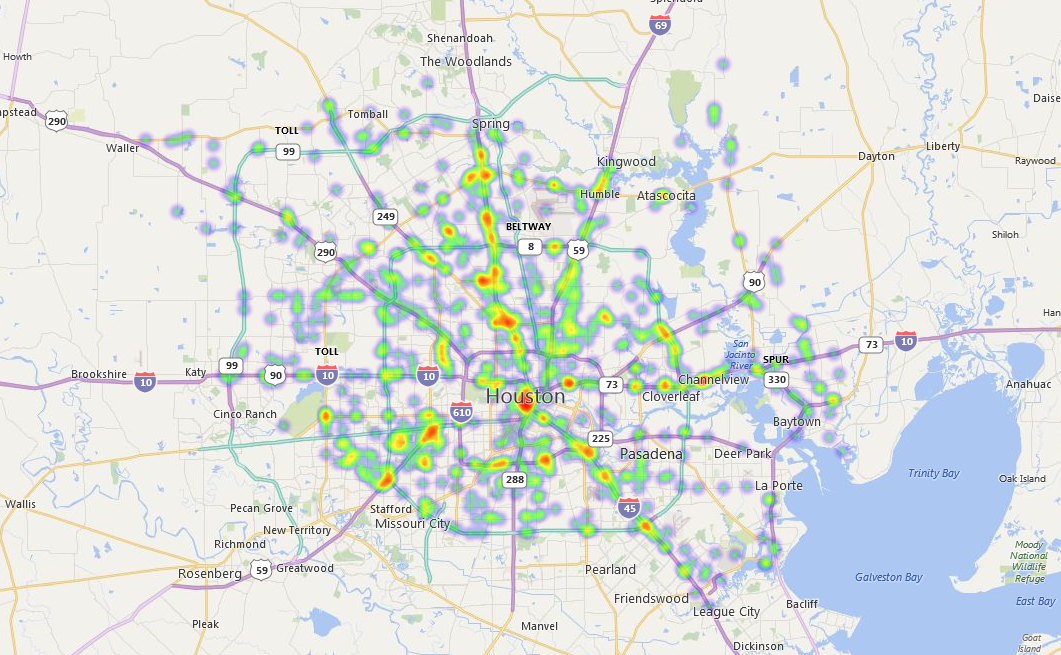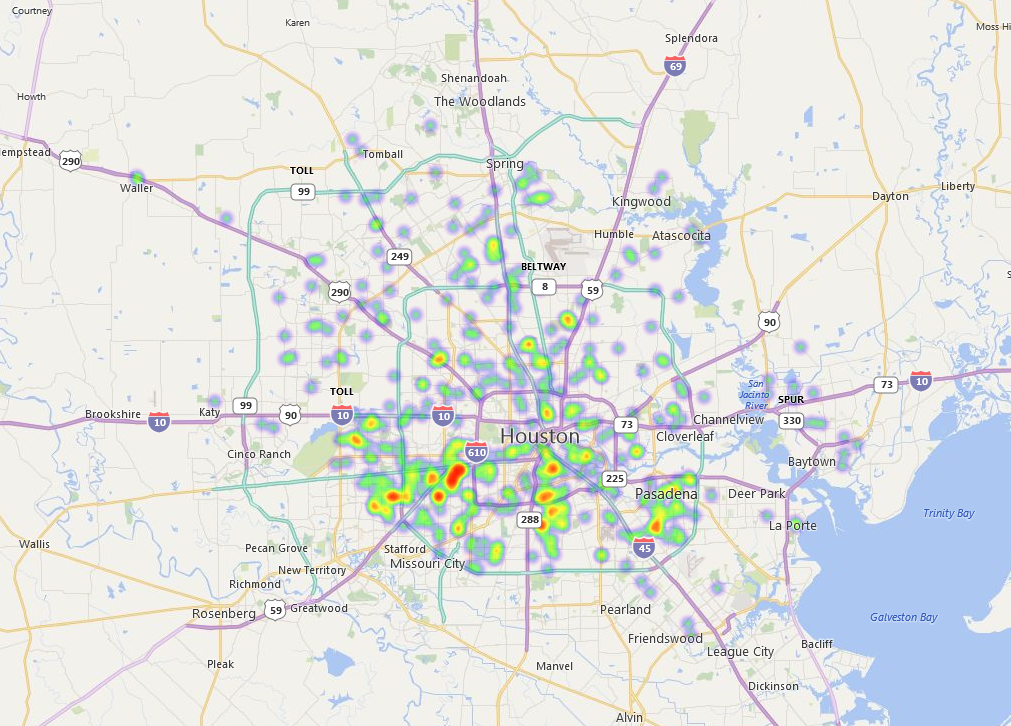In her second of a series of community outreach meetings called Civic Saturdays, newly-elected Harris County Judge Lina Hidalgo focused on transportation on February 16, 2019. The event in Gulfton, organized by LINK Houston, reflected a sense of urgency in transportation safety. Attendees shared which mode of transportation made them feel the safest, seen in the photo below. It’s clear that people walking, rolling in wheelchairs and biking do not feel safe.

Attendees shared which mode of transportation made them feel the safest. Photo provided by LINK Houston
The number of people killed while walking across the nation in 2018 was the highest in nearly 30 years according to a Governors Highway Safety Association study. The transportation safety problem in Texas and especially Harris County is not an exception. The map below shows areas where deaths are concentrated in Harris County. The darker red indicates a higher concentration. From 2017-2019, 856 people were killed and 3,812 severely injured in traffic-related crashes within the county.

Map showing the transportation-related death rates in Harris County. Source: TxDOT CRIS data
There are several key takeaways from the Civic Saturday event in Gulfton. First, there is a much-needed conversation on how Harris County can work together with cities and key organizations to address transportation safety issues. A comprehensive approach to engagement, education, enforcement, and investment in safe infrastructures requires coordination and implementation that often takes time.
Further discussion on how to build a safer infrastructure is required. The dangers lurking on the streets and our car-culture reliance are inherent to how our cities and transportation networks were built and in most cases, continue to be built. Transportation projects tend to take years and require large investments—with long-term effects on how people move across cities and access opportunities.
Another key takeaway is the importance of providing community members opportunities to voice their concerns. The transportation Civic Saturday provided another platform to elevate safety among transportation priorities for the county. The challenge for elected officials like Judge Hidalgo is to find ways to translate these voices into meaningful policy decisions.
During a breakout session that I co-facilitated, called “Road Safety for All,” participants discussed the need for education, enforcement and more investment in infrastructure that improves safety for pedestrians and cyclists, who are the most vulnerable road users. Harris County police officers pointed to the need for everyone to always be aware and alert.
Attendees also discussed how the Harris County Engineering Department, which oversees road construction within the county’s jurisdiction, largely outside Houston’s city limits. Due to the nature of low-density, sprawling suburban development in Harris County, most of the focus is on facilitating high-speed car travel.
This is problematic in several ways. First, approximately one in four traffic fatalities and nine 9, 717 people killed in 2017 were attributed to speeding in America. Second, neighborhoods built around car travel will need to accommodate other ways of getting around as these neighborhoods grow and become more densely populated. However, Harris County does not have standardized guidelines for road design to include infrastructure to make other trip modes, such as walking and biking, safer in the future.
Locally, transportation safety has been identified as a major issue in Gulfton and surrounding areas by the city’s Complete Communities Action Plan for the neighborhood, a Connect Community: A Revitalization Plan for Gulfton-Sharpstown, as well as research conducted by the Kinder Institute for Urban Research.
As the most densely-populated neighborhood in Houston, Gulfton has a much higher share of pedestrians and transit riders. Long blocks, busy intersections, a high concentration of businesses, apartment complexes, and schools lead to a very dangerous combination of neighborhood characteristics that prove to be deadly.
Safety around schools is an example where crashes are not only tragic for the victims and their families but are also traumatic for the community. Administrators, parents, and children familiar with the everyday chaos at the beginning and end of a school day repeatedly voiced their concern.
After the session, a school principal shared how one of her students was hit crossing the street in front of a school bus recently. The driver tried to beat the school bus stop sign and hit the child. The middle-schooler walked to school that day because his parent’s car broke down.
This incident highlights how low-income families tend to be more vulnerable and affected by these crashes. Moreover, the crash happened in front of other children who rushed to help their friend. These children were potentially traumatized by the sights of the crash, the principal said.
In an action plan meeting held in the afternoon later, a mother spoke out about her experience witnessing the death of 4-year-old Mohammed Ali Abdallah, in the Gulfton community. Following his death, she decided not to let her children walk to school.
Safety around schools is not a problem unique to Gulfton. The photo below shows the concentration of crashes involving pedestrians 18 years old and younger in Harris County from 2017-2019. The darker red indicates a higher concentration.

The map shows the concentration of crashes involving pedestrians 18 years old and younger in Harris County from 2017-2019. Source: TxDOT CRIS data
One of the ways to improve safety around schools is to reduce traffic around the time of drop-off and dismissal. But, it’s a chicken-and-egg situation. More children walking or biking to school mean less car traffic around school drop-off and dismissal and less chance for a deadly collision with cars and people walking. Yet, parents and students who have experienced or witnessed a near-miss or crash will likely continue to drive to school as a safety measure.
Safety is also closely connected with how schools and their surrounding environment are built. A Harris County engineer noted that most schools have included a traffic analysis of the surrounding streets to inform their construction plan, but this is not the case for older schools.
Conducting traffic analyses for older schools can inform the district and administration on how to best manage traffic during rush hours. More urgently, many schools, including those in Gulfton, can benefit from more support to add more crossing guards, highly-visible crosswalks and enforcement around school zone speed limits.
One thing is clear—improving safety for all road users is not a zero-sum game. It benefits everyone.

